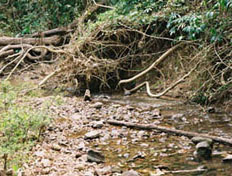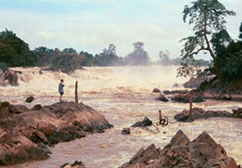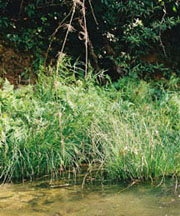Substratum / Flow and hydraulics / Seasonal variations
Light and Shadell
Light is necessary for photosynthesis, and is often a defining feature
when describing habitat. For example, fish or invertebrates may avoid
sunny spots within a stream because they are more visible to predators.
The largest influence that light has on aquatic ecosystems is its influence
on plant growth.
 The
availability of light for photosynthesis varies seasonally in temperate
regions, and is affected by factors that prevent it from reaching the
stream surface and stream bed. Small streams in forested landscapes are
shaded by forest vegetation or sometimes by valley walls. Larger streams
tend to be less shaded by forest and valley walls and more so by increased
particulate matter and water depth. As rivers increase in size, it is
easier for unobstructed light to reach their surface, but the water itself
shades its depths and so light reaching the streambed may be as limited
as in a densely forested headwater stream.
The
availability of light for photosynthesis varies seasonally in temperate
regions, and is affected by factors that prevent it from reaching the
stream surface and stream bed. Small streams in forested landscapes are
shaded by forest vegetation or sometimes by valley walls. Larger streams
tend to be less shaded by forest and valley walls and more so by increased
particulate matter and water depth. As rivers increase in size, it is
easier for unobstructed light to reach their surface, but the water itself
shades its depths and so light reaching the streambed may be as limited
as in a densely forested headwater stream.
Water temperatures and dissolved oxygen levels of streams are also influenced
by the relationship between light and shade and in particular the density
and height of streamside vegetation. A developed canopy provides shading
which helps reduce water temperature ranges and rates of fluctuation.
This reduces stress on biological populations and improves overall habitat
quality.
Substratum--
The substratum or substrate is defined as the organic and inorganic material
that makes up the bed of a river or stream. The inorganic material (ranging
in size from silt, sand and gravel to pebbles, cobbles, boulders and bedrock)
is usually eroded from the river basin slopes, river channel and banks
and modified by the current. Sediment usually refers to soil particles,
but may include organic materials that enter the water column from eroding
land. Sediment consists of particles of all sizes, including fine clay,
silt and gravel. The term sedimentation is used to describe the deposition
of sediment particles in waterbodies.
The impact of substrate on aquatic biota depends on substrate size, organic
content and interaction with other environmental factors. Not only do
different substrates harbour different assemblages of animals, but the
density, diversity and biomass of aquatic biota are also impacted. As
a general rule, diversity and abundance tend to increase with substrate
stability (which itself increases with mean particle size) and with the
presence of organic matter. Sandy substrates are thus thought to be poorest,
due to instability. Sediment may clog and abrade fish gills, suffocate
eggs and aquatic insect larvae on the bottom. Sediment may also carry
other pollutants into waterbodies. Nutrients and toxic chemicals may attach
to sediment particles on land and ride the particles into surface waters
where pollutants can settle with the sediment or become soluble in the
water column.
Substrate heterogeneity is also important in controlling biota abundance
and diversity. As mean particle size increases, physical complexity increases
up to substrates dominated by large pebbles and cobbles. Mixed substrates
provide a greater range of surfaces to colonize and microflow patterns.
Because of these relationships between particle size and heterogeneity,
the relationships among particle size and faunal diversity, biomass and
abundance are not linear. All three parameters tend to increase from sand
to cobble but decrease for large boulders and bedrock.
Flow
and Hydraulics--
Water velocity and the associated physical forces collectively represent
perhaps the most primary environmental factor affecting the biota of running
waters. The speed of current influences the size of p articles
of the substrate. Current affects food resources via the delivery and
removal of nutrients and food items. Current velocity also presents a
direct physical force that organisms experience within the water column
as well as at the substrate surface.
articles
of the substrate. Current affects food resources via the delivery and
removal of nutrients and food items. Current velocity also presents a
direct physical force that organisms experience within the water column
as well as at the substrate surface.
Organisms must shelter from the current, develop attachment devices or
perform energy costly work to hold their positions. Alternatively, they
may prefer to live in zones of the stream where there is less current.
These areas are typically located in back eddies behind obstructions,
near shore or near bottom, depending on the physical characteristics of
the stream.
Stream dwelling biota exhibit a wide variety of adaptations to use various
current situations to their benefit. Diverse attachment and food gathering
devices are found among aquatic biota including silk and other sticky
secretions, hooks, claws, suckers, sweepers and filters. Some fish exhibit
a variety of adaptations to life in fast or slow moving waters. Body shape,
swim bladder modifications and fin configuration can aid fish to hold
themselves or to feed in stronger currents.
Seasonal Variations--
The physical factors discussed above can vary greatly according to the
seasons. Temperature may limit activity during winter,  light
may be abundant in early spring but limiting after the canopy leafs out.
In temperate or high altitude regions such as the headwaters of the Mekong,
ice and snow can limit incoming light.Similarly, seasonal flow changes
are able either to increase or reduce the input of inorganic or organic
matter, nutrients and when present, man-made sources of pollution.
light
may be abundant in early spring but limiting after the canopy leafs out.
In temperate or high altitude regions such as the headwaters of the Mekong,
ice and snow can limit incoming light.Similarly, seasonal flow changes
are able either to increase or reduce the input of inorganic or organic
matter, nutrients and when present, man-made sources of pollution.
Streams in regions with low seasonal precipitation may dry up during the
dry season. This flow intermittency is a characteristic feature strongly
influencing the aquatic life and habitats of many streams in tropical
regions. Flow levels and aquatic habitats in streams at higher latitudes
and alpine areas in Tibet are more dependant on runoff from melting snows.
The flow regime and associated aquatic habitats in these streams are dominated
by ice, reduced winter discharge, and spring freshets such as high flows
due to melting snow and ice.
A key consideration in looking at the seasonal variation of stream environments
and its effects on biota is the annual hydrologic cycle of flood and drought.
Many species of invertebrates and fish are adapted to changes in discharge
and flooding. This includes migratory behaviours between dry- and wet-
season habitats and involves longitudinal and lateral movements. Some
of these have extraordinary capacities to cope with low oxygen concentrations,
high temperatures and desiccation. These same types of adaptations are
evident in many species of riparian vegetation which in turn can determine
the abundance and diversity of aquatic animals.
|
|
 |
